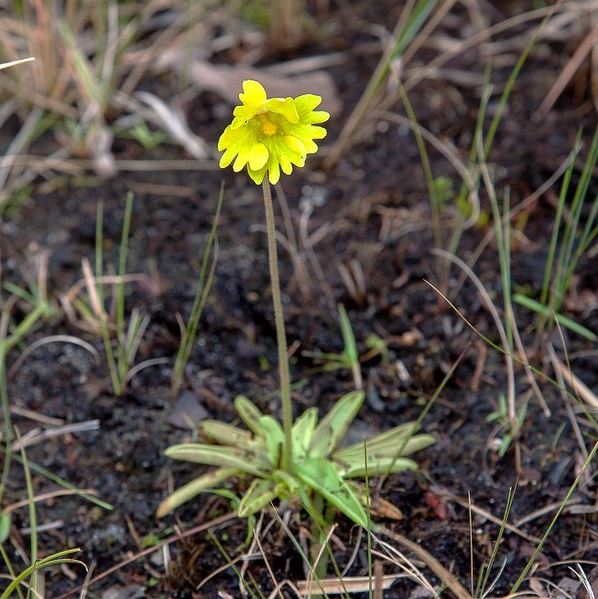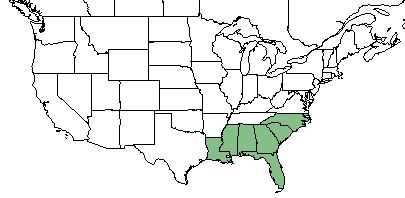Pinguicula lutea
Common name: yellow butterwort [1]
| Pinguicula lutea | |
|---|---|

| |
| Photo by John B hosted at Bluemelon.com/poaceae | |
| Scientific classification | |
| Kingdom: | Plantae |
| Division: | Magnoliophyta - Flowering plants |
| Class: | Magnoliopsida - Dicots |
| Order: | Schrophulariales |
| Family: | Lentibulariaceae |
| Genus: | Pinguicula |
| Species: | P. lutea |
| Binomial name | |
| Pinguicula lutea Walter | |

| |
| Natural range of Pinguicula lutea from USDA NRCS Plants Database. | |
Contents
Taxonomic Notes
Synonyms: none
Varieties: none
Description
P. lutea is a perennial forb/herb of the Lentibulariaceae family native to North America. [1]
Distribution
P. lutea can be found along the southeastern coast of the United States from Louisiana to North Carolina. [1]
Ecology
Habitat
P. lutea can be found in pine savannas and wet pine flatwoods, mostly in the outer Coastal Plain, rarely extending inland to seepages and sandhill-pocosin ecotones in the fall-line Sandhills of SC. [2] Specimens have been collected from wet sands of shrub bog, low swampy ground, borders of a bay, low pine woods, wet prairie, roadside ditch, savanna ecotone, pine savanna, grassy savanna, pine flatwoods, longleaf pine wiregrass ridge, edge of swamp, and open pineland.[3]
Phenology
P. lutea has been observed flowering January through May. [4] Basal rosette, lvs yellowish-green, curling upward at tips (tips appear acuminate); clammy pubescent; flr stem to 25 cm long; corolla 2.5-3.5 wide, yellow, not veined [5]
Fire ecology
P.. lutea will re-sprout after a fire. It has been observed 40 days after a burn in a mesic pine savanna with a small depression marsh. [6]
Conservation and Management
P. lutea is listed as threatened by the Florida Department of Agriculture & Consumer Services Division of Plant Industry. [1]
Cultivation and restoration
Photo Gallery
References and notes
- ↑ 1.0 1.1 1.2 1.3 USDA Plant Database https://plants.usda.gov/core/profile?symbol=PECA
- ↑ Weakley, A. S. (2015). Flora of the Southern and Mid-Atlantic States. Chapel Hill, NC, University of North Carolina Herbarium.
- ↑ URL: http://herbarium.bio.fsu.edu. Last accessed: June 2018. Collectors: Robert Kral, Robert K. Godrey, C.Jackson, S.R. Harrison, Delzie Demaree, Sidney McDaniel, R.M.S., S.W. Leonard, George Cooley, Joseph Monachino, Kathy Craddock Burks, Steve L. Orzell, Edwin L. Bridges, Luis Almodovvar, Elmar C. Prichard, Grady Reinert, Rosalind Thebaud, O. Lakela, S.C. Hood, Josephine Skehan, R.L. Wilbur, Clarke Hudson, Paul Lemon, W.P Adams, N.C. Henderson, F.S. Earle, Rodie White, Julie Neel, R. Komarek, M. Davis, Thomas E. Miller, Amanda Sang. States and counties: Florida (Liberty, Leon, Walton, Jefferson, Jackson, Gulf, Franklin, Pasco, Levy, martin, Clay, Volusia, Orange, St. Johns, Wakulla, Bay, Calhoun, Polk, Okaloosa, Santa Rosa, Washingotn) Georgia (Thomas, Grady, Berrien) Mississippi (Leon, Forrest, George, Jackson) North Carolina (Columbus) South Carolina (Charleston) Alabama (Baldwin)
- ↑ Nelson, G. PanFlora: Plant data for the eastern United States with emphasis on the Southeastern Coastal Plains, Florida, and the Florida Panhandle. www.gilnelson.com/PanFlora/ Accessed: 24 MAY 2018
- ↑ Coile, N. C. (2000). Notes on Florida �s Regulated Plant Index (Rule 5B-40), Botany Contribution No. 38, 3nd edition. Gainesville, Florida, Florida Department of Agriculture and Consumer Services, Division of Plant Industry.
- ↑ Observation by Edwin Bridges in Highlands County, Fl, December 28, 2015, posted to Florida Flora and Ecosystematics Facebook Group.